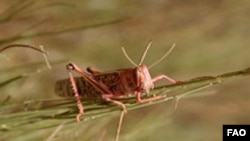Heavy rains have fallen over the past three weeks in northern Mali and Niger and that’s resulted in growing swarms of Desert locusts. Efforts are underway to contain the insects in a region that’s already food insecure.
They may be called Desert locusts, but they like rain. Keith Cressman is a Senior Locust Forecasting Officer for the U.N. Food and Agriculture Organization.
“Locusts exist normally at most times of the year in desert areas anywhere between West Africa and western India. Now they require rainfall in order to reproduce and increase in numbers. So the rains provide the sandy soil with moisture for their eggs, and those eggs hatch after about two weeks. And then after about another six weeks, the wingless nymphs -- juvenile locusts -- get wings and become adults,” he said.
And when the rain is heavy – as it has been in northern Mali and Niger – the stage is set for swarms.
“They have the ability to take advantage of unusually good conditions. And when they do that it’s at this point that they can increase in large numbers very rapidly. And then they can threaten agricultural production zones in that country,” said Cressman.
The locusts arrived in Mali and Niger last month from Algeria and Libya, where infestations were first reported in January. The FAO says insecurity in Algeria and Libya hampered control operations, allowing the locusts to migrate across the Sahara.
Cressman said that the heavy rains not only provide good conditions for breeding, but may result in a second generation of locusts in another month or two. Those swarms could pose new threats to Algeria and Libya and threaten harvests in West Africa’s Sahel region.
“If you can imagine that a locust swarm – a cloud of locusts – has billions of insects, this means that a small part of a single swarm can eat the same amount of food in one day as about 2,500 people. So imagine if we have a number of swarms around in a particular country, it can have a very significant impact on not only the agricultural production in that country, but on that country’s food security,” he said.
While ground control operations have been underway in Niger since early June, political conflict has prevented similar efforts in northern Mali. More than 30 pickup trucks and other locust control equipment were looted.
The FAO is asking for $10 million to expand control operations. This is in addition to country-level spending. Cressman said if the $10 million dollars is spent before a plague develops, it can save up to half a billion dollars a year or two later in trying to control and contain it.
The FAO is also closely monitoring locusts that have been seen in eastern Chad and Sudan’s Darfur region.
They may be called Desert locusts, but they like rain. Keith Cressman is a Senior Locust Forecasting Officer for the U.N. Food and Agriculture Organization.
“Locusts exist normally at most times of the year in desert areas anywhere between West Africa and western India. Now they require rainfall in order to reproduce and increase in numbers. So the rains provide the sandy soil with moisture for their eggs, and those eggs hatch after about two weeks. And then after about another six weeks, the wingless nymphs -- juvenile locusts -- get wings and become adults,” he said.
And when the rain is heavy – as it has been in northern Mali and Niger – the stage is set for swarms.
“They have the ability to take advantage of unusually good conditions. And when they do that it’s at this point that they can increase in large numbers very rapidly. And then they can threaten agricultural production zones in that country,” said Cressman.
The locusts arrived in Mali and Niger last month from Algeria and Libya, where infestations were first reported in January. The FAO says insecurity in Algeria and Libya hampered control operations, allowing the locusts to migrate across the Sahara.
Cressman said that the heavy rains not only provide good conditions for breeding, but may result in a second generation of locusts in another month or two. Those swarms could pose new threats to Algeria and Libya and threaten harvests in West Africa’s Sahel region.
“If you can imagine that a locust swarm – a cloud of locusts – has billions of insects, this means that a small part of a single swarm can eat the same amount of food in one day as about 2,500 people. So imagine if we have a number of swarms around in a particular country, it can have a very significant impact on not only the agricultural production in that country, but on that country’s food security,” he said.
While ground control operations have been underway in Niger since early June, political conflict has prevented similar efforts in northern Mali. More than 30 pickup trucks and other locust control equipment were looted.
The FAO is asking for $10 million to expand control operations. This is in addition to country-level spending. Cressman said if the $10 million dollars is spent before a plague develops, it can save up to half a billion dollars a year or two later in trying to control and contain it.
The FAO is also closely monitoring locusts that have been seen in eastern Chad and Sudan’s Darfur region.








